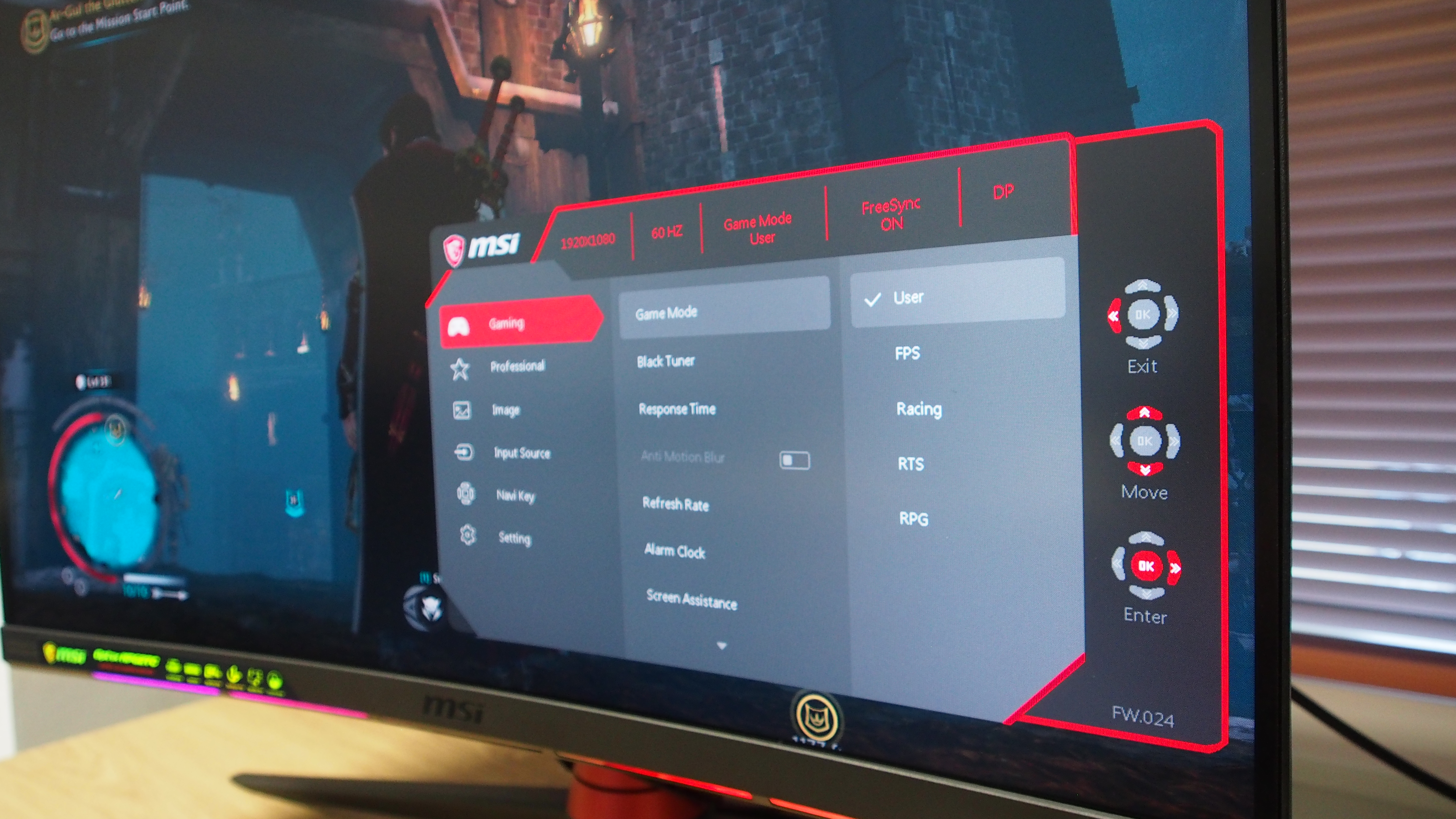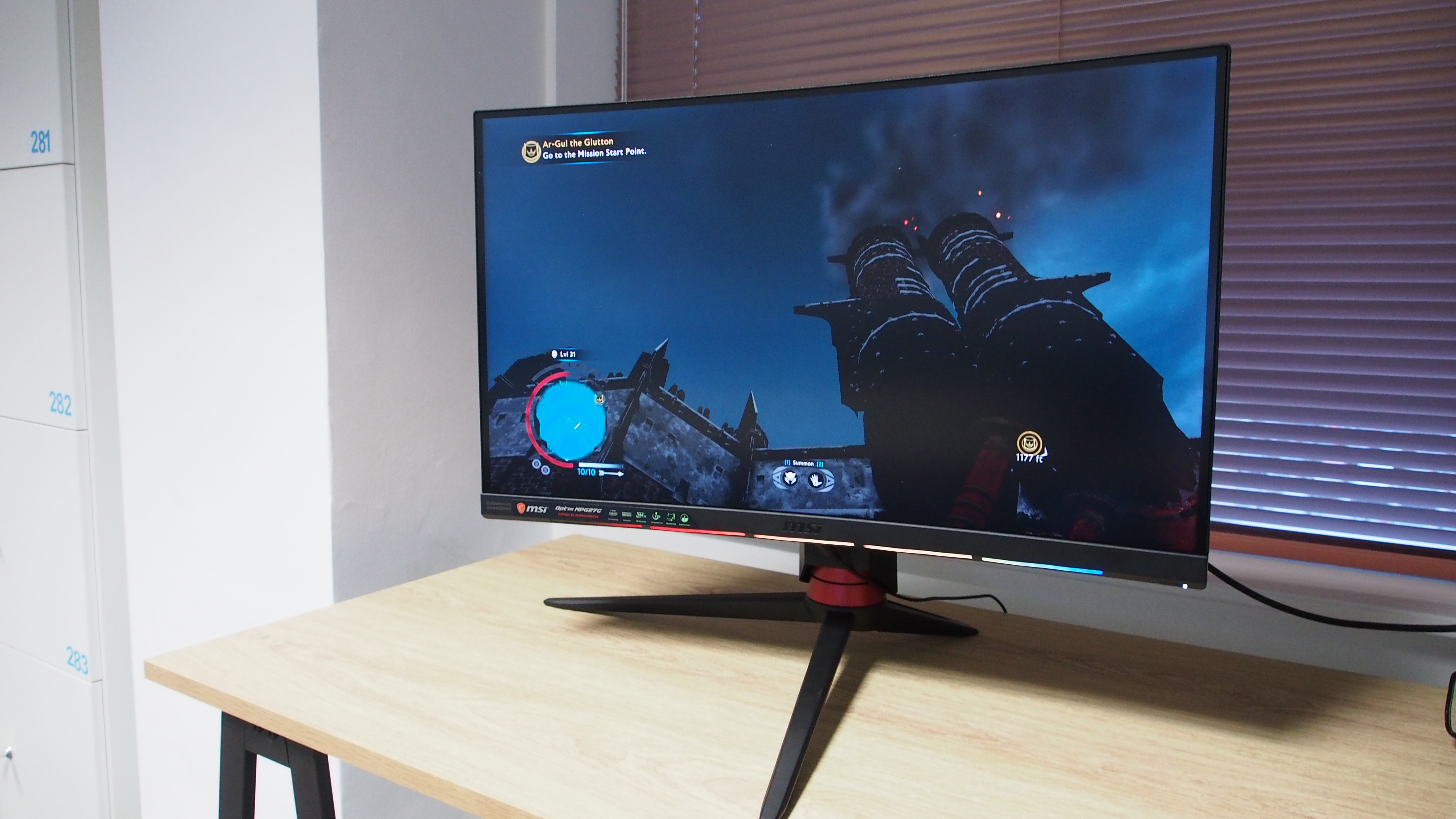TechRadar Verdict
If you play fast-paced games and don't care about high resolutions, the 1080p MSI Optix MPG27C is worth considering. However, more demanding gamers may be disappointed.
Pros
- +
High refresh rates
- +
Good image quality
- +
Thin bezels
- +
Good price
Cons
- -
Relatively low resolution
- -
RGB lighting won’t be for everyone
- -
Needs tweaking out of the box
Why you can trust TechRadar
MSI is a respected name when it comes to creating PC gaming gear, producing graphics cards, motherboards and peripherals (as well as laptops and desktops) with a level of performance and polish that's always welcome.
The MSI Optix MPG27C is one of the brand’s latest gaming monitors. It’s not as bombastic as the 4K, HDR gaming screens we’ve been seeing lately, nor does it have an outrageous size or ultra-wide aspect ratio.; by the standards of some modern gaming monitors, it’s a bit sedate.
However, there’s a lot to be said for a gaming monitor that doesn’t rely on gimmicks or intimidating size, but instead does a great job of making your games run as well and look as good as possible.
That’s not to say the MSI Optix MPG27C lacks tricks or features, though. A high refresh rate of 144Hz is aimed at keeping games running fast and smooth, while the 'frameless' design means a series of these monitors can be placed side-by-side to make for a seriously immersive experience.

Price and availability
The MSI Optix MPG27C sells for $449.99 (£398.99, around AU$740) which is more than similarly-specced 1080p gaming monitors like the Asus MG248Q. The fact that the MSI Optix MPG27C is more pricey than the Asus boils down to the fact that the MSI is more recent, and that it boasts a curved screen, which is increasingly popular in gaming monitors.
It’s still priced lower than the Alienware 25 Gaming Monitor AW2518H ($699.99, £670, around AU$870) and the BenQ Zowie XL2540, which costs $496.99 (£429.99, AU$699). While the Zowie XL2540 is smaller than the Optix MPG27C (24 inches versus 27 inches), it justifies its higher price (somewhat) with its incredibly high refresh rates of 240Hz.
If you’re looking for monitors with higher resolutions, like the 4K HDR Asus ROG Swift PG27UQ, then you’ll be faced with much higher prices. Overall, the MSI Optix MPG27C is priced about right for the features it offers, and if you want to take advantage of its slim bezels and have a number of them on your desk, it won’t prove prohibitively expensive.
Sign up for breaking news, reviews, opinion, top tech deals, and more.

Design
As gaming monitors go, the MSI Optix MPG27C has a rather restrained look. This is mainly thanks to the much-touted 'frameless design', which means the bezels on either side of the screen, as well as along the top, are incredibly thin.
This means that despite the screen size of 27 inches, the MSI Optix MPG27C takes up less space on your desk than other 27-inch screens. It’s also a monitor that wouldn’t look out of place on a desk if you use your PC for work as well as gaming.
However, the MSI Optix MPG27C still offers plenty of nods to its gaming heritage. Its base and stand have a sharp, metallic design that compliments MSI’s other gaming products, like its MSI Aegis 3 gaming PC.
It also comes with the almost-obligatory RGB lighting, which shines from the back in a nice-looking circuit board-like design. RGB LEDs are also located on the front of the monitor, along the bottom bezel. If you find this distracting, you can turn it off using the onscreen menu.

Speaking of the menu, it can be activated via a small joystick on the back of the screen, which can be pressed to select items and used to move through the menus. Personally, we find this method a lot easier to use than fumbling about for various buttons on the bottom or back of the monitor, which other screens often use.

The MSI Optix MPG27C is slightly curved, with a 1800R curvature. It’s quite a subtle effect, particularly considering the size and aspect ratio of the screen and especially compared to ultra-wide curved screens or large TVs. However, if you're planning on getting a number of these monitors to use side-by-side, the curved design should produce a more immersive experience.
The Optix MPG27C connects to the mains via a power adaptor (so no being able to use any old power lead), and ports-wise you get two HDMI 1.4 ports, a single DisplayPort 1.2, a 3.5mm headphone jack and a USB 2.0 input that turns the monitor into a USB hub, with two USB outputs on the left-hand side of the screen along with another audio output jack and a mic input jack.

It’s not the widest range of ports, and nor are they the most up-to-date versions, but as the MSI Optix MPG27C is ‘only’ a 1080p display, and doesn’t support HDR, what's here will suffice. It's a shame the USB isn't USB 3.0, though.
Performance
During our time with the MSI Optix MPG27C we tried a number of games from a variety of genres. Because of the relatively low resolution and high refresh rates, this monitor excels at games that aren’t necessarily graphical showcases, but which require lightning-fast reflexes. Online and competitive games are particularly well suited to this monitor.
We paired the Optix MPG27C with the new MSI Aegis 3, which is a powerful but not ridiculously over-the-top, gaming PC. Playing the likes of Shadow of Mordor and Far Cry 5 at 1080p at Ultra settings we found the gameplay was fast, smooth and responsive.

We did need to head into the onscreen menu to turn on FreeSync, which allows for smooth gaming and no screen tearing when paired with a compatible graphics card. The menus are well laid out, and as we mentioned the small joystick (called the 'NaviKey') on the rear of the monitor makes navigating to the right setting easy.
You can also configure the NaviKey to bring up shortcuts – although the sheer amount of options on offer may be overwhelming for some people. It’s not helped by some options being grayed out unless you turn on another option first; this can prove confusing, but for people who like to have full control over how their monitor looks, this level of configurability will be good news.

As you'd expect, there are a range of preset modes you can select that are geared towards different game genres, such as Racing, FPS and RPG. We didn’t really like any of these presets, though, with some making the picture look washed out while others looked too dark. We’re not entirely sold on the need to have different monitor modes for different types of games (we prefer tweaking a monitor until the picture suits our needs, and leaving it at those settings to play our games on), but the option is nice to have.
You can tweak each preset to better reflect your preferences, while there’s also a 'User' option that enables you to create your own preset from scratch.
So, with a bit of tweaking, the MSI Optix MPG27C performs well for gaming, although you’ll want to spend some time in the menus setting up things just right.
Outside of games, the MSI Optix MPG27C does well, but the 1080p resolution over a 27-inch screen doesn’t look brilliant, especially with 1440p and 4K monitors becoming more common, and giving you much more space to work with.
There’s also a professional mode, and combined with the MSI Optix MPG27C’s excellent contrast and very good color accuracy (99% of the sRGB color space, for example), it does a good job for non-game applications that require color accuracy.
However, this is a monitor that we’d only really recommend for 1080p gaming. For other tasks, or for people who want to play at higher resolutions, the MSI Optix MPG27C is not for you.
Verdict
What kind of gamer you are, and the type of games you play, will have a bearing on whether or not the MSI Optix MPG27C is for you. It’s a very competent gaming monitor with some nice features and excellent configurability, but you’ll need a bit of patience to tweak its options to get the best image quality.
As for what kind of gamer you are, if you like fast-paced competitive games where notching up kills is more important than graphical bells and whistles, this is a monitor that will be worth your money.
If you like playing racing games, and want to have a number of monitors for a more immersive experience, then the combination of the MSI Optix MPG27C’s fast refresh rates, thin bezels and decent price will also make this an attractive proposition.
However, if the games you play are more about large screen sizes, high resolutions and HDR, then you’ll find the MSI Optix MPG27C seriously lacking, and you'll be better off spending your money elsewhere.
Overall, the MSI Optix MPG27C is a good gaming monitor that concentrates on the specific needs of certain gamers, and does its job very well – and if you're once of those gamers you’ll be very pleased with its performance and price. Most others, however, are likely to feel a little short-changed.

Matt is TechRadar's Managing Editor for Core Tech, looking after computing and mobile technology. Having written for a number of publications such as PC Plus, PC Format, T3 and Linux Format, there's no aspect of technology that Matt isn't passionate about, especially computing and PC gaming. He’s personally reviewed and used most of the laptops in our best laptops guide - and since joining TechRadar in 2014, he's reviewed over 250 laptops and computing accessories personally.
